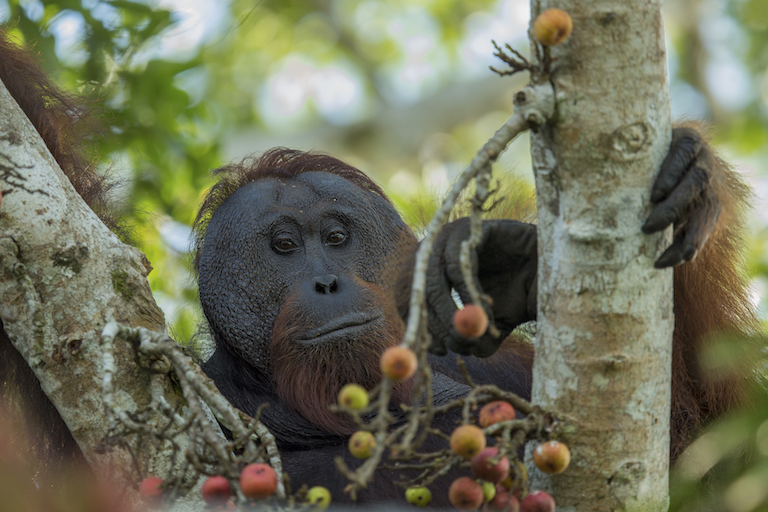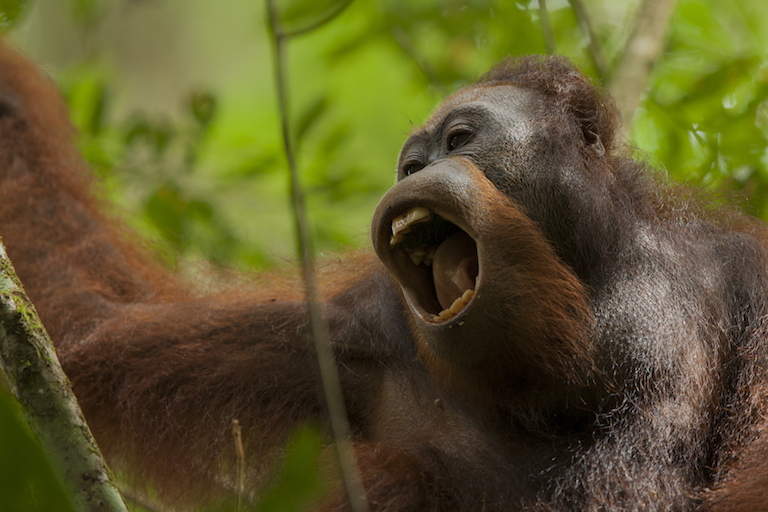- The fossil record shows that orangutan numbers and range declined rapidly in the late Pleistocene area; by 12,000 years ago they remained in only around 20 percent of their original range.
- A recent study concludes that the twin pressures of climate change and human hunting were responsible for this rapid decline.
- The study’s authors say their research indicates that humans and orangutans have co-existed for millennia, and can continue to do so if proper conservation measures are taken.
- Their research suggests that far more attention needs to be paid to the impact human hunting has on modern orangutan populations.
Orangutans face a changing climate and are hemmed in by a growing human population using novel technologies to hunt them down. It’s a situation they have been in before — 20,000 years ago.
A recent paper suggests that research about what happened in the past can inform conservation strategies today. In Orangutans venture out of the rainforest and into the Anthropocene, published in June in Science Advances, Stephanie N. Spehar of the University of Wisconsin, Oshkosh, and her colleagues survey evidence about the past interactions of humans and orangutans reaching back tens of thousands of years.
In highlighting just how long humans and orangutans have been interacting, it suggests that co-existence is possible, but it needs to be planned for.
“Orangutans have been impacted by humans for a long time — much longer than we might have assumed previously,” Spehar says. “That’s important because it helps us to understand what the major threats to orangutans are now in this age when humans are having greater impacts than ever before.” That understanding, the authors conclude, needs to incorporate a broader view of managing landscapes and more attention to the mostly neglected effects of hunting.

Explaining past orangutan population declines
Orangutans used to be far more broadly distributed than they are today. During the Pleistocene (2.6 million to 12,000 years ago), species from the genus Pongo lived in a wide area spanning southern China, mainland Southeast Asia, and the Sunda Shelf, a landmass connecting what are now the islands of Sumatra, Java and Borneo.
The fossil record shows that toward the end of the Pleistocene, orangutans began to disappear from many places. By the Pleistocene/Holocene boundary (12,000 years ago) they remained only on Borneo and Sumatra — about 20 percent of their original range. The density of their population in these areas also declined.
Two explanations have been considered for this. One is the effect of global shifts in climate during the Pleistocene, when the climate grew cooler and then warmed again multiple times. Forest cover would have been lost in the cooler and dryer periods, causing fragmentation of habitat and increased seasonal variation, and affecting the availability of food.
The problem with this hypothesis is that orangutans appear to have weathered all these shifts fairly well except for the one at the end of the Pleistocene. “Orangutans handled them all, so why couldn’t they handle this last one?” Spehar says. “There must have been something else going on.”

Human impact on orangutans in the past
That “something else” may well have been human beings.
Co-author Terry Harrison of New York University says there’s an interesting comparison to be made between orangutans and gibbons. “In the Pleistocene, orangutans and gibbons had pretty much the same distribution,” he says. “It’s interesting that gibbons have retained most of that range into modern times.”
A likely explanation for this difference is that orangutans were more affected by hunting. Gibbons are small, fast, very arboreal primates. Orangutans are large and slow-moving. “They’re easier to hunt, and when you hunt, you get more meat from the hunt than from a gibbon,” he says. Orangutans also reproduce more slowly than smaller primates like gibbons, so their population numbers can’t be replenished as quickly. What’s more, he says, when humans arrived in orangutan range in mainland Asia, orangutans were living in less densely forested environments, which made them easier to hunt.
There isn’t specific evidence of hunting in those areas, which is not an easy thing to find in the fossil record, but there’s one site that shows that humans have in fact hunted orangutans for a very long time. Orangutan remains are among the large amount of animal remains found at Niah Cave in northern Borneo, where evidence of human activity goes back 50,000 years. These remains must have been introduced by humans, as large numbers of orangutans weren’t likely to have just strolled into the caves and died there; there’s also evidence of cooking, from the charring of the bones.
The authors also note that the technology to hunt tree-dwelling animals effectively only became widespread in Southeast Asia around the Pleistocene/Holocene boundary. Niah Cave also provides some evidence of the effects of this. Remains from the late Pleistocene include evidence of light throwing spears or arrows, and this correlates with an increase in the remains of arboreal primates including orangutans. Up until about 35,000 years ago, about 15 percent of the animal remains found in the cave came from arboreal primates. By the late Pleistocene, they accounted for up to 49 percent of the total.

Implications for the present
The authors don’t deny that climate had an effect; rather, they argue that climate change on its own can’t account for orangutans’ decline in the late Pleistocene. Instead, a combination of climate stresses and human impact pushed them over the edge in most of their range until they persisted only in remote, heavily forested areas.
This analysis makes the past even more relevant to the present, when orangutans are again under both kinds of pressure. “Combine climate change with other human impacts, like severe deforestation and hunting, and you’re giving a lot of wildlife combined factors they can’t withstand,” Spehar says. “It’s a lesson for the present.”
What do the authors suggest that modern conservationists do with this lesson? The conventional approach to orangutans posits that they are highly sensitive to the environment, overwhelmingly arboreal, and lived in pristine habitat in the past. The assumption, then, is that they’re doomed outside protected areas of undisturbed habitat, and the main strategy should be to protect such areas.
But since history shows that orangutans have been subject to human influence for 70,000 years, recreating the pristine environment that existed before we affected them isn’t a very realistic goal. The good news is that perhaps we don’t have to. Along with the fact that orangutans have persisted alongside us for that long, a growing body of research shows that they are in fact very adaptable and can use a variety of habitats, including some human modified ones, as long as they can move between them. What they need are management strategies that take advantage of this.
“We need to broaden our thinking about land use policies and take what’s called a landscape approach: how do we incorporate areas outside protected areas into orangutan conservation,” Spehar says.

However, it’s also important that some of that evidence from the past suggests there’s one kind of human impact they can’t withstand: hunting. It may be surprising that it’s necessary to delve back thousands of years to make that point, but it’s something that isn’t frequently studied in the present and has rarely been a focus of orangutan conservation efforts. “The vast majority of killings go undetected and unpunished,” says study co-author Erik Meijaard, from the conservation NGO Borneo Futures. “It is a tricky issue and few groups want to touch it.”
Meijaard adds that despite the attention given to palm oil development, it’s not the biggest threat. “We lose the most animals in selectively logged forest,” he says. “Ecologically these forests are great for orangutans and population declines there are most likely caused by hunting. This is supported by long term surveys and interview data.”
The ultimate conclusion of the paper is perhaps one that it’s hard to argue against: it’s time to meet orangutans at least halfway. “Orangutans have spent a long time adapting to us,” Spehar says. “They’ve gone as far as they can go and now it’s our turn — we have to adapt and be tolerant too.”
Banner Image: Dominant male orangutan (pongo pygmaeus) feeding on ficus fruits in Danum Valley, Malaysian Borneo. Image by Charles Ryan/Sticky Rice Travel.
FEEDBACK: Use this form to send a message to the author of this post. If you want to post a public comment, you can do that at the bottom of the page.
